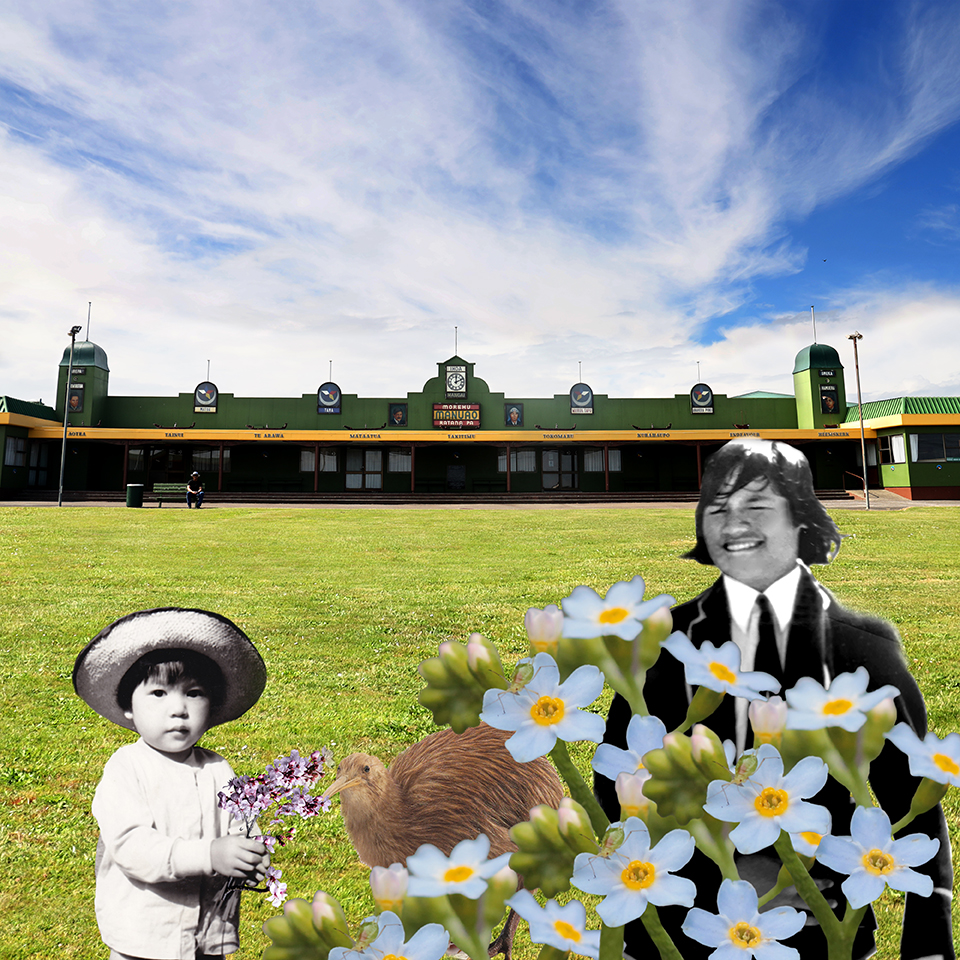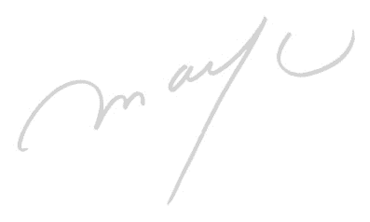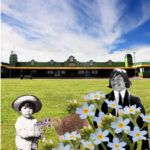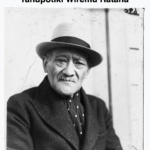
ラータナ村のアンドレ Andrei at Rātana pa 2023
午後2時の約束の時間より少し早めに到着し、指定された寺院の脇にある駐車スペースにレンタカーを停め、アンドレを待った。彼との初めて出逢いに、胸をワクワクさせながら。
彼はT.W.ラータナの長女ラウィニアの孫にあたる。ラータナ教会フェイスブック・ページに問い合わせたら、教会の管理人が返事をくれ、ラータナ村に住むアンドレを紹介してくれた。管理人はアンドレの従兄弟だと言う。
水曜日の午後だったこともあり、みんな仕事に出払ってしまっているのか、駐車場の周りには誰も見あたらない。そこで私は、ラータナ村の唯一のジェネラル・ショップ(よろず屋)と郵便局が並ぶ大通りに面したベンチに腰を下ろし、ここならアンドレが来るのが見えるはずだと思って、待つことにした。午後2時丁度、彼は既に寺院の中にいたのか、どこからともなくアンドレが私の前に姿を表した。
年齢は60になるかならないか。しかし精悍な感じで、心温かく、初対面の私にすぐ「プレゼントがある」と、二十枚ほどのコピー用紙の束を差し出してくれた。表紙には、第二代マオリ王、トュカロト・タウィアオ (Tūkāroto Tāwhiao 1822年 頃– 1894年)のモノクロ写真がカラーでコピーされている。表紙に手書きで書かれている文字は、マオリ語で「我らの王」という意味だとアンドレが教えてくれた。
凛々しい王様の肖像の斜め上にラータナのシンボル、青、赤、白、桃色と紫色の五芒星と、紺の三日月にT.W. RATANA と金文字で書かれたエナメル・ブローチがセロテープで貼られている。このプレゼントを私に手渡し、「後で読むように」と言いながらも、寺院の前の道端で、用紙をめくりながらその概要を語ってくれた。それは大正13年(1924年)、T.W.ラータナがロンドン万博からの帰途の途中、日本を訪れた際の話である・・・。
日本滞在中に、T.W.ラータナの次女マータが結婚式を挙げたと言う。その時の写真がある。日本ホーリネス教団の中田重治司教が婚礼の式を行い、新郎のボイス・フエヌアロは黒留袖姿と羽織袴姿で写っている。同行したミュージシャン達に囲まれたラータナ夫妻の集合写真もある。また中田重治との記念写真では、なんとラータナは羽織袴姿で右手に日本刀を持っている。片や中田重治は、マオリのクロークをはおり、ヘッドバンドを額に巻き、右手にはマオリの槍を持っている。
他にニュージーランドのラータナ寺院内の写真も納められ、ラータナの数々の予言やワイタンギ条約の内容なども、そこに記されていた。
アンドレが特に熱心に話してくれたのが、『ラータナ寺院1928年:最後の釘と日本のコイン』と題するページについてである。
そのページには、大正13年(1924年)に発行された日本の五十銭銀貨両面の写真と共に、歴史研究者ハレルイア・アペラハマの説明書きもあった。
ラータナ教会は1925年に創立され、寺院の建設は1927年に完了した。完成に合わせ、日本から中田重治司教が1927年の暮れにラータナ村を訪問したのである。そして翌年1928年、T.W.ラータナの誕生日の1月25日に、完成の祝賀が行われ、その際、寺院の「建設作業、締めくくりの最後の釘」として、日本の銀貨を祭壇の中心部に打ち込まれた。銀貨が発行された年は、T.W.ラータナが日本との友好関係を始めた大正13年で、それを記念して銀貨が有終を飾ったのである。
銀貨の表の図柄は、菊、桐、二羽の鳳凰の絵に「五十銭」と文字が描かれ、 裏面には、旭日の絵を中心に、周りに一重咲きの桜、そして文字で、「大日本」及び発行年号が刻まれている。
ラータナが感じたという、銀貨に描かれている図柄のシンボル的な意味合いについても、アンドレは熱心に語ってくれた。
まず旭日旗。ラータナ一行を乗せた船が横浜港に入港した時、ラータナは港に浮かぶ沢山船の旭日旗を目にし、ライジング・サン (Rising Sun / Rising Son = 御子)と解釈した。すなわちイエス・キリストが天へと昇るシンボルと受け止めたのである。ラータナと中田の間では旭日に特別な意味を授けていたのだ。
そして表の二羽の鳳凰。これはそれぞれマオリ国と日本国を示していると言う。
1927年末からラータナ村に滞在していた中田重治は、その年のクリスマスの日に、日本人は北の星の守り人であり、マオリは南の守り人である。そして、神の御子の再臨、イエス・キリストの地上での契約の成就を告げるものであると説教したと言われる。
また日本の行く末を見て取ったラータナの予言が、鳳凰や桜の図柄に象徴されている。1924年11月に横浜港に入港した時、浮かぶ船の旭日旗を眺めながら、「大きな二つの光と共に日本に大きな悲劇起こる。しかし、いずれ大きな力を持つ国となると」と彼は予言した。それは日本が第二次世界大戦の焼け跡から不死鳥、鳳凰のように蘇るということを象徴しているのである。そして日本が蘇り、力ある国になった時、自分達マオリを忘れないで欲しいと言い残し、銀貨の表側にある、二つの一重咲きの桜を勿忘草(わすれなぐさ)の花だと示したと言う。
・・・こうアンドレは語ってくれた。内容は、後日読んだハレルイア・アペラハマが書いた説明文や、著者キース・ニューマン氏の『Ratana Revisited: An Unfinished Legacy』に書かれているものとほぼ同じ内容だった。しかしアンドレという「語り部」のような子孫を通して語られたこれらの話は、活字で読む歴史とは違い、私の心の奥に、温かく染み入ったのだった。
2023年1月29日
金森マユ
訳: ハレルイア・アペラハマ
紹介フェイスブック: ランギ・ラウィティ
参考文献
- Ratana Revisited,: An Unfinished Legacy, キース・ニューマン著者 Keith Newman, Reed Press 2006年
- 歴史研究者ハレルイア・アペラハマ Hareruia Aperahama の説明書
- アンドレ・メイソン Andre Masonとの会話
***
I tae tōmua tata ake nei au i te wā i tohua ai, tū tonu taku motukā rīhi i te tūnga motukā i tahakī mai o te Temepara tatari ake ai ki a Anarei. Anarei, hei tūtakitanga tuatahi tēnei mōku, he uri mokopuna tonu nā te tamahine mātāmua o TW.Rātana, i a Rawinia. Nō taku toronga atu ki te pukamata o Te Hāhi Rātana, nā te ringa whakahaere tonu ahau i whakatūaki atu ki tōna ake whanaunga, ki a Anarei, e noho nei i Rātana Pā.
Nā runga i te mea he awatea Rāapa, kāti, i te ngaro pea te katoa ki te mahi, ā, he matangaro kē kāhore kau tētahi i kitea. Noho iho nei au i te paepae noho i te anganui ki te tiriti matua, ko te toa me te whare poutāpeta kotahi noa nei i Rātana Pā i kite ai au, ka tatari kia puta ake a Anarei, ka mutu, i puta ohorere noa ake Ia mai i kore wāhi kē i te 2pm tonu.
“He koha tāku māu” hei ko tāna me te hōmai i ētahi whārangi kape ruatekau nei. I te matanui o te haupū kape kara-kano nei he whakaahua pango me te mā ko te Kīngi Māori tuarua ko Tūkāroto Tāwhiao (c. 1822-1894). Nā Anarei i kī mai he tuhinga nā te ringa e mea ana,’Ko Kīngi’ i te reo māori.
He tohu mārō hei tohu Rātana – he purū, whero, mā, māwhero me te pāpura rima matarau me te piko o te marama, ko T.W.Rātana kua tuhia ā koura nei – he mea whakapiri hauroki ki runga rawa ake i te kanohi o te Kīngi. Ahakoa inā tā Anarei kī mai kia waiho mō muri atu pānui ai, kia ahatia, haere tonu nei āna whakamārama i ngā kiko kōrero o roto pepa kape i a māua e tū ana i waho o te Temepara.
Tērā tētahi whakaahua whakamahara ko Juji Nakada rāua ko T.W.Rātana i tangohia ai i tōna haerenga ki Tiapani 1924. E kākahuria nei a T.W.Rātana ki te haori hakama me te pupuri hoari i tōna ringa matau, kāti ko Juji Nakada e mau korowai ana me te tīpare i tōna rae me te tao i tōna ringa matau. He whakaahua kē atu rā i tangohia ai i tōna noho i Tiapani, he whakaahua hoki i te tamahine tuarua i a Māta, me tōna tāne i a Boyce Whenuaroa e mau kāhahu tomosode pango me te haori hakama, ā kāti nā Juji Nakada i whakahaere te mārena mō rāua.
He whakaahua ā rōpu hoki ko T.W.Rātana me tōna wahine me ngā kai whakatangitangi i haere tahi atu ai, ā, e karapoti nei i a Ia ; āpiti ana, he whakaahua o ngā tohu i roto i tō rātou temepara, waihoki ko ngā tini kupu matakite nā T.W.Rātana me ngā kōrero a Te Tiriti o Waitangi.
Ko te whārangi e ingoatia nei ‘Rātana Temple 1928: te nēra mutunga me te kapa tiapani’ e rua ngā taha o te whakaahua nei he kapa tiapani 50 hiriwā Sen nō te tau 1924, ka mutu he whakamārama poto nā te kai rangahau hītori nei nā Hareruia Aperahama.
Te Hāhi Rātana, i whakatūria i te tau 1925, i tīmataria ai te hanga temepara i Rātana Pā, otirā i oti ai i te tau 1927. Hei whakanui, he mea mātoro nā Juji Nakada ki Rātana ka mea i te 25 o Hanuere, i te rā whānau tonu o T.W.R i te tau 1928, kia kotahi heneti tiapani hei whakaoti i te hanganga ai o te temepara, kātahi ka titia e ia ki waenga pū o te āta tuahu. Nō te tau 1924 te moni nei, te tau tonu i tīmata ai hoki te whanaungatanga.
Ko te tohu i te kanohi o te moni hiriwā he putiputi kiroheniama, he pua paurowīnia me ngā manu manaia e rua otirā he tuhinga ‘50 Sen’, heoi kei tua mai he tohu i waenganui ko te rā e kake ana (Rā Whiti / Tama nui te Rā) , arā ko te aranga o Ihu Karaiti. I te wā i a Juji Nakada e noho ana i te pā o Rātana mai i te mutunga o te tau 1927, nāna te kī i te rā kirihimete i taua tau, ko te iwi Tiapani ngā kaitiaki o ngā whetū i te raki, waihoki, mā rāua tahi e pōwhiri i a tama nui te rā, te hokinga tuaruatanga mai o te tama a Te Atua, hei whakatutuki i te kawenata tapu o Ihu Karaiti i te whenua.
Ko ngā manu manaia me ngā pua tiēri hei tohu anō hoki i ngā kupu matakite nā Rātana: i tōna matoro ki Tiapani i te Noema 1924, i a T.W.Rātana e titiro ake ana ki te ‘haki o te rā kake ana’ i runga i te kaipuke, nāna i poropiti : Tērā ka kā ki runga o Tiapani e rua ngā maramatanga nui, ka kino hoki. Heoi hei te wā ka huri a Tiapani hei whenua mana nui. Ko te tohu o te manu manaia, tēra ia ka ara ake i te puehu me te takakino o te pakanga tuarua o te ao.
Nāreira nā konei a Rātana ka inoi ake ina ara ake a Tiapani i ngā puehutanga, ā, kātahi ka mana nui, kia kaua rawa e wareware ki te iwi māori. Nāna nei hoki ngā puapua pū e rua i tautuhi i te taha nui o te moni hriiwa hei putiputi ‘kaua e wareware ki au’.
Ko te kōrero nā Anarei i taua rā i te hāngai pū ki tāku i pānui ai i te whakamārama a Hareruia Aperahama rāua tahi ko Keith Newman i tāna pukapuka arā ‘ Rātana Revisited’: An Unfinished Legacy’. Ahakoa ina kāhore i rite ki tāku i pānui ai i te tuhituhinga ai, i taua wāhi tonu i te kōrero pū nei a Anarei, me te mea nei ko Ia i te kōrero hāngai mai nei māku.
***
I arrived a little earlier than the appointed time, parked my rental car in the parking space by the temple and waited for Andre. Andre, whom I was meeting for the first time, is the grandson of T.W. Rātana ‘s eldest daughter, Rawinia. When I contacted the Rātana Church Facebook page, the page admin introduced me to his own cousin, Andre, who lives in Rātana pa.
As it was a Wednesday afternoon, everyone had probably gone off to work, and no one was to be seen. I sat on a bench facing the main street, which with the only shop and a post office in Rātana pa, and waited, thinking I would be able to see Andre as he came, but he appeared out of nowhere at exactly 2pm. He was probably already in the temple.
“I have a gift for you,” he said and gave me a stack of about twenty photocopied pages. On the front of a stack was a colour copy of a black-and-white photograph of the second Maori king, Tūkāroto Tāwhiao (c. 1822-1894). Andre told me that the handwritten text said, ‘Our King’ in Maori language.
An enamel broach with the symbol of Rātana – a blue, red, white, pink and purple five-pointed star and a dark blue crescent moon with T.W. RATANA written in gold letters – was attached with cello tape diagonally above the dignified portrait of the King. Although Andre said I could read it later, nevertheless, he explained the contents printed photocopy paper whist we were standing outside of the temple.
There is a commemorative photograph with Juji Nakada, taken when T.W. Rātana went to Japan in 1924. T.W. Rātana is dressed in haori hakama and holds a Japanese sword in his right hand, while Juji Nakada is wearing a Maori cloak with a headband around his forehead and a spear in his right hand. There is another photo taken during his stay in Japan, a photograph of T.W. Rātana ‘s second daughter, Marta, and the groom, Boyce Huenuaro, in black tomesode and haori hakama, when Juji Nakada performed the wedding ceremony for them. There is a group photograph of Mr and Mrs T.W. Rātana surrounded by the musicians who accompanied them on tour; photographs of the symbols inside their temple, as well as T.W. T.W. Rātana ‘s numerous prophecies and the contents of the Treaty of Waitangi were included.
The page entitled ‘Rātana Temple 1928: the last nail and Japanese coin’ had a photo of both sides of a Japanese 50 sen silver coin issued in 1924, along with an explanatory note by historian Hareruia Aperahama.
The Rātana Church, founded in 1925, began construction of a temple in Rātana pa, which was completed in 1927. To celebrate, Juji Nakada from Japan visited R and said on 25 January, T.W. Rātana ‘s birthday in 1928, that the last nail in the construction of the temple would be a Japanese silver coin, and he nailed it in the centre of the altar. The coin was dated 1924, indicating the year when the friendship began.
The design on the front of the silver coin is a picture of a chrysanthemum, paulownia and two phoenixes with the inscription ’50 sen’, while the reverse has a picture of the rising sun in the centre, surrounded by single-flowered cherry blossoms and the inscription ‘Dai Nihon’ and the year of issue. He also told us more about the significance of the symbols on this silver coin.
When the ship carrying T.W. Rātana and his crew entered the port of Yokohama, Ratana saw the rising sun on many ships in the harbour and took it as a symbol of the Rising Sun (Rising Sun / Rising Son), i.e. the ascension of Jesus Christ. Juji Nakada, who had been living in Ratana pa since the end of 1927, said that on Christmas Day that year, the Japanese were the guardians of the northern stars and the Maori people were the guardians of the southern star, and both were to herald the Rising Sun / Son, the second coming of the Son of God, the fulfilment of the covenant of Jesus Christ on earth.
Phoenixes and cherry blossoms also illustrate Rātana ‘s prophecy: during his visit to Japan in November 1924, T.W. Rātana, looking at the rising sun flag erected on the ships predicted: ‘With two great lights, a great tragedy will happen in Japan. But in time it will become a country of great power. The phoenix symbolised that Japan would rise like from the ruins of the Second World War.
Rātana then asked that when Japan rose from the ashes and became a powerful nation, to not to forget the Maori people. He thus indicated that the two single blossoms on the front side of the silver coin were the flowers of the forget-me-not.
Andre’s account that day was in line with what I later read in Hareruia Aperahama’s account and author Keith Newman’s book Ratana Revisited: An Unfinished Legacy, but unlike the history I read in print, when Andre spoke in person on site, everything felt as if it was directly relevant to me. I took everything in directly, innocently as a child, and felt that Andrei’s words were meant for me.
29 January 2023.
Mayu Kanamori
Maori language translation by: Hareruia Aperahama
Introduction by: Rangi Rawhiti HeMorehu Ahau via Facebook
References
Andre Mason, conversation in person and online with Andre Mason, 2022
Historical explanation document by Hareruia Aperahama
Rātana Revisited: An Unfinished Legacy, Keith Newman, Reed Press 2006
Image: Andrei at Ratana pa, Mayu Kanamori 2022, Mixed media collage; Kiwi courtesy of Te Papa Tongarewa OR.012028 and Andre Mason



